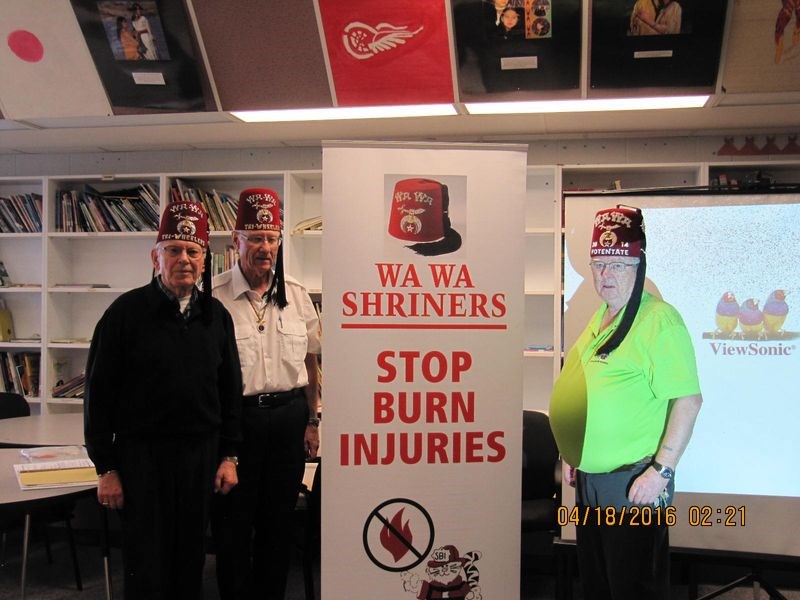¬Ý ¬Ý ¬Ý ¬Ý ¬Ý ¬Ý ‚ÄúBefore you go out, the candle goes out,‚Äù Ken Eskdale of Regina, the Stop Burn Injuries chair and instructor for the Wa Wa Shriners, told students from Kindergarten to Grade 5 last week.
¬Ý¬Ý¬Ý¬Ý¬Ý¬Ý¬Ý¬Ý¬Ý¬Ý¬Ý Eskdale, accompanied by fellow Shriners Al Makowsky of Kamsack and Leroy Charbonneau of Theodore, talked about burn care at Chief Gabriel Cote Education Complex and Keeseekoose Chiefs Education Centre on April 18. He talked about the awareness of burn injuries and how to prevent them.
¬Ý¬Ý¬Ý¬Ý¬Ý¬Ý¬Ý¬Ý¬Ý¬Ý¬Ý Eskale put particular emphasis on each room of the house.
¬Ý¬Ý¬Ý¬Ý¬Ý¬Ý¬Ý¬Ý¬Ý¬Ý¬Ý Of great importance was to be sure to extinguish candles as they are often used in living rooms, bathrooms ad bedrooms, and as a result continue to be an extreme hazard in the home. He pointed out other hazards including cooking oils, scalding water from kettle or tap and hot ovens. To avoid a hot water burn, the students were advised to always turn on the cold water tap first, followed by the hot water tap until a desired temperature is reached. Electrical cords, lamps, auxiliary heaters, fireplaces and chemicals were discussed as potential fire hazards and burns.
¬Ý¬Ý¬Ý¬Ý¬Ý¬Ý¬Ý¬Ý¬Ý¬Ý¬Ý Should an unfortunate incident occur in which a fire was present, Eskale gave specific instructions on how to prepare to exist the home or school. Exiting may require crawling on hands and knees or checking a door before opening it by using the back of a hand as it is more sensitive than is the palm and can detect heat better.
¬Ý¬Ý¬Ý¬Ý¬Ý¬Ý¬Ý¬Ý¬Ý¬Ý¬Ý Every attempt should be made to exit even if through a window and jumping to safety, he said. Once out of the building, everyone should meet at a designated spot, or muster point. The students were told to never return into a burning building to try and retrieve a toy or pet.
¬Ý¬Ý¬Ý¬Ý¬Ý¬Ý¬Ý¬Ý¬Ý¬Ý¬Ý Eskale interacted with the students when he asked some of them to help demonstrate what should be done if their clothing catches fire. They were instructed to cover their faces with their hands in order to protect their eyes as they ‚Äústop, drop and roll‚Äù until the flames are out.
¬Ý¬Ý¬Ý¬Ý¬Ý¬Ý¬Ý¬Ý¬Ý¬Ý¬Ý A video was shown to help demonstrate the topics of the presentation.
¬Ý¬Ý¬Ý¬Ý¬Ý¬Ý¬Ý¬Ý¬Ý¬Ý¬Ý The students were also made aware of the dangers of lawnmowers when Eskale said that the engine should be fully cool before –°¿∂ ”∆µ refueled by an adult and that riding mowers should not be occupied by more than one operator. He also suggested –°¿∂ ”∆µ careful around campfires.
‚ÄúNo horseplay around the campfire is a warning to be heeded,‚Äù he said, emphasizing that¬Ý smoke detectors should be on every floor of a home with batteries always left in place and should be examined annually to be certain they work.
Forty years after opening its first Shriners Hospital, the Shrine of North America became aware of another enemy of children - the severe burn, said Eskale’s information. Each year, thousands of children are disfigured or killed by what has been called one of the greatest hazards of childhood.
Recognizing the lack of medical expertise in the burn care field, in the mid-1960s the Shriners opened three Shriners Hospitals specifically to treat burns, each with the three-fold purpose of: ¬Ýhelping children; conducting burn research, and training medical personnel in the treatment of burn injuries.
Shriners Hospitals provide acute and rehabilitative care for children who have been burned and are located in Boston, Cincinnati, Galveston and Sacrament.
Since the mid-1960s, when the Shrine first made a commitment to advancing burn treatment by opening these specialized hospitals, a burned child's chance of survival has more than doubled, the information said.
Today, Shriners Hospitals remain pioneers in burn treatment, it said. They are actively involved in developing many major advances that will continue to revolutionize the way burn patients will be treated.
The Shrine reinforces its commitment to research and improvements in burn treatment through affiliations with the outstanding medical schools.
The Shriners Burn Hospitals are staffed and equipped to treat the following: patients with acute, fresh burns; patients needing reconstructive or restorative surgery as a result of healed burns; patients with severe scarring, resulting in contractors of interference with mobility of the limbs, and patients with facial scarring and deformity.
The sooner a burned child reaches a Shriners Hospital, the better his/her chances of recovery, it said.
A non-emergency admission for burn care is dependent on the medical needs of the patient and on the availability of beds, it said. Shriners Hospitals are open to children up to their 18th birthday, regardless of race, religion or relationship to a Shriner. Applications forms for non-emergency admissions to Shriners Hospitals can be obtained by talking to a Shriner.
“All services are provided regardless of a patient’s ability to pay.”




